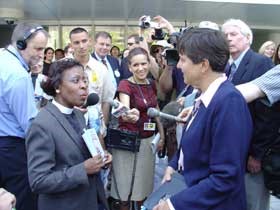 Photo: Civil Society Team
Photo: Civil Society Team
CSOs have been targeting the World Bank Group for 25 years in an effort to influence its economic, social, and environmental policies. Many of these advocacy campaigns have been quite contentious and critical over the years, the most visible being the ‘50 Years is Enough” campaign of the 1990s which called for the abolishment of the Bank. While this particular campaign was obviously not successful, it is clear that some of the most important Bank reforms adopted over the years – environmental safeguards, compliance mechanisms, and access to information – were spearheaded by civil society.
Building on this long advocacy tradition, an increasing number of Bank-watcher CSOs are undertaking external evaluations to assess and improve the impact of their efforts. These have included the Bank Information Center (BIC) in Washington, Bretton Woods Project (BWP) in London, and Both Ends in Amsterdam. These advocacy assessments followed similar methodologies including retrospective analysis of Bank policies and interviews with key interlocutors such as government officials, donor agency representatives, and even Bank staff. Even though these assessments focused on differing policy areas, they reached similar conclusions. First, that advocacy CSOs need to sharpen their analysis on specific Bank policies and programs. Second, while civil society advocacy has been successful in some areas, CSOs shouldn’t over estimate the policy impact they can have more generally. Third, CSOs need to build more rapport with Bank managers and staff in order to achieve their advocacy goals.
In addition to the assessments, CSOs have continued to publish handbooks and guides geared to improving the efficacy of their advocacy efforts on the Bank. The most recent of these is a toolkit published by BIC titled Executive Director Advocacy Toolkit: A Guide to Influencing the World Bank Board of Directors. The publication examines the role of Executive Directors, suggests ways to approach EDs, and shows how to design advocacy campaigns. The guide provides specific advice on how to influence EDs. It states, for instance, that activists should make clear that they are not going to “surprise or attack” EDs but want to have a constructive dialogue. This means that CSOs need to “go beyond rhetorical positions and criticisms of the Bank” and present evidence for their positions and propose solutions to problems. In a nod to pragmatism, the guide reminds activist that “there are no permanent allies and no permanent enemies” in this policy arena. Even if EDs have opposed your positions in the past, “there are always opportunities to work together positively in the future”.
These evaluations and guides demonstrate that advocacy CSOs are becoming more savvy and effective about influencing policies at the Bank Group. The fact that they sought out Bank staff views on the quality of their advocacy efforts, also shows that they are more confident and willing to more closely engage the Bank.
